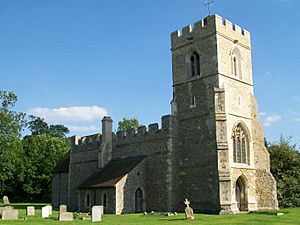Great Wymondley facts for kids
Quick facts for kids Great Wymondley |
|
|---|---|
 St Mary's Church, Great Wymondley |
|
| OS grid reference | TL213287 |
| Civil parish |
|
| District |
|
| Shire county | |
| Region | |
| Country | England |
| Sovereign state | United Kingdom |
| Post town | Hitchin |
| Postcode district | SG4 |
| Dialling code | 01438 |
| Police | Hertfordshire |
| Fire | Hertfordshire |
| Ambulance | East of England |
| EU Parliament | East of England |
| UK Parliament |
|
Great Wymondley is a small village in Hertfordshire, England. It's located near the town of Hitchin. Even though it's called "Great Wymondley," it's actually a smaller place than its nearby village, Little Wymondley. In the past, in 1931, about 285 people lived here.
Contents
Exploring the Landscape
Great Wymondley is surrounded by lovely farmland. This area is part of the "Green Belt," which means it's protected from too much new building. The ground here is made of a type of soil called boulder clay, which lies over chalk.
Ancient Field Patterns
Did you know that some of the field shapes around Wymondley might be really old? A historian named Frederic Seebohm studied the local villages in the late 1800s. He thought that the way fields were laid out in Wymondley showed links to Roman times.
The Romans had special land surveyors called gromatici. These surveyors helped organize land, including field boundaries. Seebohm believed that Wymondley's old open field system, which you can see on old maps, kept some of these ancient Roman boundaries. This suggests that the land might have been managed in similar ways for a very long time, even before the Anglo-Saxon settlement in England!
A Look Back in Time
Great Wymondley has a long history. It was even mentioned in the Domesday Book, a famous survey from 1086. The Domesday Book recorded that the Wymondley area had 58 households. Experts have used this information to learn about both Great and Little Wymondley.
Great Wymondley used to be its own separate area, called a civil parish. But on April 1, 1937, it joined with Little Wymondley to form one larger parish called Wymondley.
Amazing Old Buildings
Great Wymondley is home to some very old and interesting structures.
Ruins and Earthworks
There are two special historic sites here that are protected:
- Wymondley Roman Villa: These are the remains of an old Roman house. They are found near Ninesprings, by the River Purwell. Parts of the villa have been dug up by archaeologists.
- Great Wymondley Castle: You can still see the earthworks of this old castle! It was a motte-and-bailey castle, which means it had a big mound (motte) with a tower and a walled area (bailey). These earthworks are about 20 meters east of St Mary's Church.
Buildings Still Standing Today
- St Mary the Virgin Church: This beautiful church is a very important historical building. It has parts that were built in the Norman style, which was popular after 1066. The nave (the main part of the church) and the chancel (the area around the altar) are Norman. The chancel is shaped like a half-circle and is made of small, rounded stones.
- Delamere House: This is an elegant building from the Elizabethan period.
- Thatched Cottages: You can also see several charming cottages with thatched roofs. One row of these cottages is even named after the wives of King Henry VIII!


